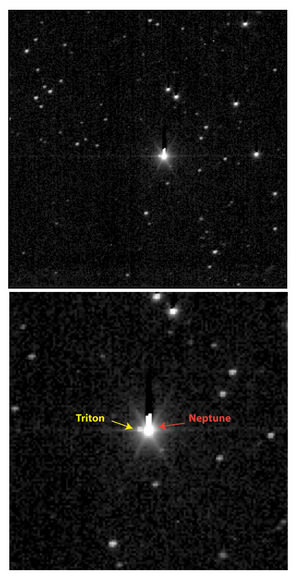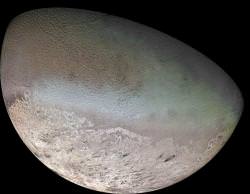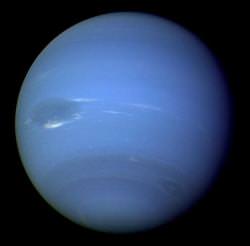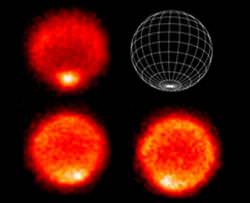Researchers studying Neptune’s atmosphere found evidence that a comet may have hit the planet about two centuries ago. Was this a “cold-case” file re-opened, or did they discover a way to travel back in time to witness a long-ago event? To make the discovery, a team from the Max Planck Institute for Solar System Research actually used the Herschel Space Telescope’s PACS (Photodetector Array Camera and Spectrometer) instrument, along with what was learned from observations from when the Shoemaker-Levy 9 hit Jupiter sixteen years ago.
Continue reading “Comet Whacked Neptune 200 Years Ago”
40 Years of Summer on Triton
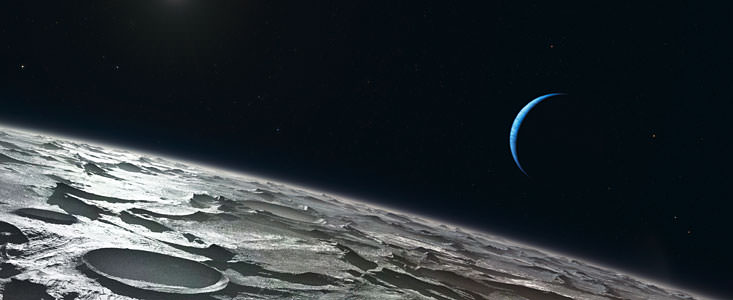
[/caption]
If you’re planning a trip to Neptune’s moon Triton, you’ll want to head to the southern hemisphere where it’s now just past mid-summer. Yes, distant Triton actually does have seasons, astronomers at ESO’s Very Large Telescope recently determined. “We have found real evidence that the Sun still makes its presence felt on Triton, even from so far away,” said astronomer Emmanuel Lellouch in an ESO press release. “This icy moon actually has seasons just as we do on Earth, but they change far more slowly.” According to the first ever infrared analysis of Triton’s atmosphere, the seasons last about 40 Earth years. But while summer is in full swing in Triton’s southern hemisphere, there’s no need to pack your bikini. The average surface temperature is about minus 235 degrees Celsius.
Oh, and you’ll also want to bring along a little breathable air. The ESO team also – unexpectedly – discovered carbon monoxide in Triton’s thin atmosphere, mixed in with methane and nitrogen.
The astronomer’s observations revealed that Triton’s thin atmosphere varies seasonally, thickening when warmed. When the distant sun’s rays hits Triton at their best summer angle, a thin layer of frozen nitrogen, methane, and carbon monoxide on Triton’s surface sublimates into gas, thickening the icy atmosphere as the season progresses during Neptune’s 165-year orbit around the Sun. Triton passed the southern summer solstice in 2000.

So, while this action increases the thickness of the atmosphere, thus increasing the atmospheric pressure, you’ll still need a pressure suit as well for your visit. Based on the amount of gas measured, Lellouch and his colleagues estimate that Triton’s atmospheric pressure may have risen by a factor of four compared to the measurements made by Voyager 2 in 1989, when it was still spring on the giant moon. The Voyager data indicated the atmosphere of nitrogen and methane had a pressure of 14 microbars, 70,000 times less dense than the atmosphere on Earth. The data from ESO shows the atmospheric pressure is now between 40 and 65 microbars — 20,000 times less than on Earth.
Carbon monoxide was known to be present as ice on the surface, but Lellouch and his team discovered that Triton’s upper surface layer is enriched with carbon monoxide ice by about a factor of ten compared to the deeper layers, and that it is this upper “film” that feeds the atmosphere. While the majority of Triton’s atmosphere is nitrogen (much like on Earth), the methane in the atmosphere, first detected by Voyager 2, and only now confirmed in this study from Earth, plays an important role as well.
“Climate and atmospheric models of Triton have to be revisited now, now that we have found carbon monoxide and re-measured the methane,” said co-author Catherine de Bergh. The team’s results are published in Astronomy & Astrophysics
If we could actually visit Triton, it would likely be a very interesting destination as we know it has geologic activity and a changing surface – plus its unique retrograde motion would offer a unique view of the solar system.
While Triton is the seventh largest moon in our solar system, its distance and position from Earth makes it difficult to observe, and ground-based observations since Voyager 2 have been limited. Observations of stellar occultations (a phenomenon that occurs when a Solar System body passes in front of a star and blocks its light) indicated that Triton’s surface pressure was increasing in the 1990’s. But a new instrument on the VLT, the Cryogenic High-Resolution Infrared Echelle Spectrograph (CRIRES) has provided the chance to perform a more detailed study of Triton’s atmosphere. “We needed the sensitivity and capability of CRIRES to take very detailed spectra to look at the very tenuous atmosphere,” said co-author Ulli Käufl.
These observations are just the beginning for the CRIRES instrument, which will be extremely helpful in studying other distant bodies in our solar system, such as Pluto and other Kuiper Belt Objects. Pluto is often considered a cousin of Triton with similar conditions, and in the light of the carbon monoxide discovery on Triton, astronomers are racing to find this chemical on the even more distant Pluto.
Source: ESO
New Horizons Spots Neptune’s Moon Triton
[/caption]
New Horizons got a great shot of Neptune’s moon Triton last fall, as it was trucking toward Pluto and the Kuiper Belt.
The mission was 2.33 billion miles (3.75 billion kilometers) from Neptune on Oct. 16, when its Long Range Reconnaissance Imager (LORRI) locked onto the planet and snapped away. The craft was following a programmed sequence of commands as part of its annual checkout. NASA released the image Thursday afternoon.
Mission scientists say the shot was good practice for imaging Pluto, which New Horizons will do in 2015. Neptune’s moon Triton and Pluto — the former planet retitled in 2006 as the ambassador to the Kuiper Belt — have much in common.
“Among the objects visited by spacecraft so far, Triton is by far the best analog of Pluto,” said New Horizons Principal Investigator Alan Stern.
Triton is only slightly larger than Pluto, boasting a 1,700-mile (2,700-kilometers) diameter compared to Pluto’s 1,500-mile (2,400-kilometer) girth. Both objects have atmospheres primarily composed of nitrogen gas with a surface pressure only 1/70,000th of Earth’s, and comparably cold surface temperatures. Temperatures average -390 degrees F (-199 degrees C) on Triton and -370 degrees F (-188 degrees C) on Pluto.
Triton is widely believed to have once been a member of the Kuiper Belt that was captured into orbit around Neptune, probably during a collision early in the solar system’s history. Pluto was the first Kuiper Belt object to be discovered.
Furthermore, “We wanted to test LORRI’s ability to measure a faint object near a much brighter one using a special tracking mode,” said New Horizons Project Scientist Hal Weaver, of Johns Hopkins University, “and the Neptune-Triton pair perfectly fit the bill.”
LORRI was operated in 4-by-4 format (the original pixels are binned in groups of 16), and the spacecraft was put into a special tracking mode to allow for longer exposure times to maximize its sensitivity.
Mission scientists also wanted to measure Triton itself, to follow up on observations made by the Voyager 2 spacecraft during its flyby of Neptune in 1989. Those images revealed evidence of cryovolcanic activity and cantaloupe-like terrain. New Horizons can observe Neptune and Triton at solar phase angles (the Sun-object-spacecraft angle) that are not possible to achieve from Earth-based facilities, yielding new insight into the properties of Titan’s surface and Neptune’s atmosphere.
New Horizons is currently in electronic hibernation, 1.2 billion miles (1.93 billion kilometers) from home, speeding away from the Sun at 38,520 miles (61,991 kilometers) per hour. LORRI will continue to observe the Neptune-Triton pair during annual checkouts until the Pluto encounter in 2015.
LEAD IMAGE CAPTION: The top frame is a composite, full-frame (0.29° by 0.29°) LORRI image of Neptune taken Oct. 16, 2008, using an exposure time of 10 seconds and 4-by-4 pixel re-binning to achieve its highest possible sensitivity. The bottom frame is a twice-magnified view that more clearly shows the detection of Triton, Neptune’s largest moon. Neptune is the brightest object in the field and is saturated (on purpose) in this long exposure. Triton, which is about 16 arcsec east (celestial north is up, east is to the left) of Neptune, is approximately 180 times fainter. All the other objects in the image are background field stars. The dark “tails” on the brightest objects are artifacts of the LORRI charge-coupled device (CCD); the effect is small but easily seen in this logarithmic intensity stretch. (Credit: NASA/Johns Hopkins University Applied Physics Laboratory/Southwest Research Institute)
Source: NASA
Pluto Spacecraft Gets Brain Transplant
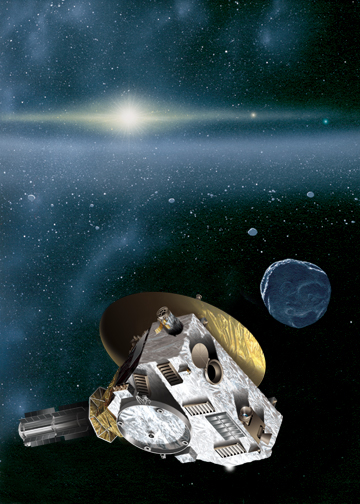
[/caption]
Still seven years away from its rendezvous with Pluto, the New Horizons spacecraft was awoken from hibernation for the second annual checkout of all systems. The spacecraft and its team back on Earth will also undergo three months of operations as the New Horizons will make observations of Uranus, Neptune, and Pluto. But the first order of business was uploading an upgraded version of the software that runs the spacecraft’s Command and Data Handling system. “Our ‘brain transplant’ was a success,†says New Horizons Principal Investigator Alan Stern. “The new software – which guides how New Horizons carries out commands and collects and stores data – is now on the spacecraft’s main computer and operating, over a billion miles from home!â€
The mission ops team at the Johns Hopkins Applied Physics Laboratory (APL) in Laurel, Maryland, radioed the software load and the commands to start it earlier this week through NASA’s Deep Space Network of antennas to the spacecraft, now just more than 1.01 billion miles (1.62 billion kilometers) from Earth. In the next 10 days the team will beam up additional new software for both the spacecraft’s Autonomy and Guidance and Control systems.
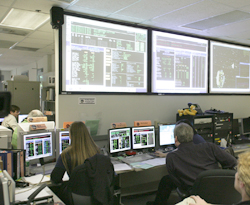
Alice Bowman, New Horizons mission operations manager at APL, says the spacecraft and its computers are healthy. “The new software fixes a few bugs and enhances the way these systems operate, based on what we’ve learned in running the spacecraft in the nearly three years since launch,†she says. “They also configure the onboard systems to be ready to support the Pluto-Charon encounter rehearsals scheduled for next summer.â€
New Horizons is more than 200 million miles beyond Saturn’s orbit and more than 11 astronomical units (1.02 billion miles) from the Sun, flying about a million miles per day toward Pluto. Annual Checkout 2 (ACO-2) continues through mid-December; follow its progress through frequent updates on the New Horizons Twitter page.
Source: New Horizons Press Release
How Old is Triton’s Surface?
With all of the press going to the moons of Jupiter and Saturn, it’s about time that Neptune got a turn. Triton, one of the moons of Neptune, is curious, with large swaths of the planet resembling the skin of a cantaloupe and a retrograde orbit (opposite that of Neptune’s rotation). Its surface is thought to be rather young, and a new method of counting the craters that pock the moon may push the age of Triton’s surface back even younger than previously thought.
Dr. Paul Schenk of the Lunar and Planetary Institute in Houston, and Kevin Zahnle of the NASA Ames Research Center in California revisited the pictures of Triton’s surface that the Voyager 2 spacecraft took in 1989. By clarifying the images with current technology, they were able to count with very high accuracy the amount of craters, and determine the possible causes of the craters. Their results were published in the July 2007 issue of the journal Icarus, in a paper titled On the negligible age of the surface of Triton.
“Our new crater counts benefit from several improvements in the quality of the Voyager images. Although this does not make invisible craters visible, it does increase the ability to discriminate impact features on Triton,” the researchers wrote.
The images showed that the leading hemisphere — the hemisphere of the planet in the direction of its orbit around Neptune — contains many more craters than that of the trailing hemisphere. Triton is tidally locked to Neptune, which means that – like our Moon – an observer on Neptune would always see the same face of Triton. Thus, the same hemisphere would always face the direction of Triton’s orbit around Neptune.
The researchers propose, “Our map of craters on Triton indicates that all definitive impact craters are on the leading hemisphere. The apparent cratering asymmetry of Triton is extreme. The absence of craters on the trailing hemisphere, and the low frequency of craters near the boundary between leading and trailing hemispheres is unique in the Solar System.”
Since Triton is rotating in the opposite direction of everything else that goes around Neptune, it acts like a giant “vacuum cleaner,” and picks up any debris orbiting the planet in a prograde (the same as Neptune’s rotation) direction.
Triton is thought to have given itself a makeover very recently because it was captured by Neptune long ago; most likely, Triton was one body in a binary system, and when Neptune captured it, the other body was thrown out of the Solar System. After being captured, all of the energy that went into slowing Triton down into orbit around Neptune was transferred into heat that melted the surface and interior of the planet. This heat could have lasted for millions of years, and the tidal energy from Neptune may still warm the interior of Triton today.
Normally, areas that have less craters have been resurfaced more recently, and thus are generally younger than surfaces with lots of craters. By analyzing the density of the craters, and using information about the type and frequency of debris that possibly caused them, the researchers were able to calculate that the terrain on the trailing hemisphere with less craters than that of the leading hemisphere was actually older than the area with more craters.
“Whatever their origin, the paucity of impact craters (and heliocentric craters in particular) suggests that Triton’s surface is very young, younger than 100 million years and possibly as young as a few million years. A return to Neptune and its vigorous, dynamic moon Triton is long overdue,” the researchers wrote.
Source: Icarus
Podcast: Neptune
We’ve reached Neptune, the final planet in our tour through the solar system – but don’t worry! The tour’s not over, but after this week we’ll be all out of planets. Neptune has a controversial story about its discovery, some of the strongest winds in the solar system and some weird moons.
Click here to download the episode
Neptune – Show notes and transcript
Or subscribe to: astronomycast.com/podcast.xml with your podcatching software.
Neptune’s South Pole is the Warmest Place on the Planet
Here on Earth we think of the poles as cold places, but on Neptune, it’s just the opposite. New images of the planet’s southern pole show that it’s actually 10-degrees warmer than the rest of Neptune. Now don’t pack your bathing suit just yet, Neptune’s average temperature is still -200 degrees Celsius (-328 F); so it’s still really, really cold.
The images were gathered using the European Southern Observatory’s Very Large Telescope (now that’s how you name a telescope). The observatory uses a special mid-infrared camera/spectrometer to reveal the different temperatures across planet.
Obviously Neptune is different from the Earth, but consider this. The planet is located 30 times farther away from the Sun than the Earth. This means only 1/900th the sunlight reaches Neptune than what we get here on Earth. Still, it’s enough sunlight to warm up the southern pole, which is currently tilted towards the Sun.
It’s been receiving the warmth from the Sun for about 40 years now, and the ongoing input of solar energy continuously heats up the polar region to the point that it’s warmer than any other part of Neptune by about 10 degrees Celsius. This heating also whips up the planets winds into some of the strongest in the Solar System. On Neptune, winds can travel more than 2,000 km/hour, faster than any other planet – you definitely don’t want to bring your swimsuit.
The temperatures in the region are high enough that methane gas, normally frozen out of the upper atmosphere, can actually leak out through the region. And this helps explain why scientists have seen abundances of this molecule in the atmosphere.
Original Source: ESO News Release
Are There Oceans on Neptune?
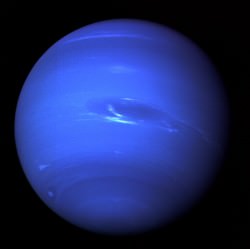
Continue reading “Are There Oceans on Neptune?”
Three Trojans Found in Neptune’s Orbit
Researchers have discovered three new objects sharing trailing behind Neptune in the same orbit. These asteroid-sized objects are locked into stable positions – called Lagrange points – through their interaction with Neptune’s gravity; Jupiter has over 1800 Trojans of its own. Astronomers had already discovered one Trojan for Neptune, so this raises its total to 4. The discovery was made using the Carnegie 6.5 Magellan Telescopes in Chile and the 8-meter Gemini North telescope on Mauna Kea, Hawaii.
Continue reading “Three Trojans Found in Neptune’s Orbit”
Three Neptunes Orbiting Another Star
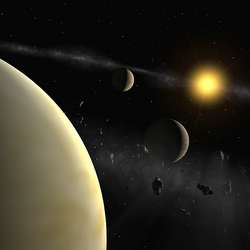
An artist’s impression of a planetary system around HD 69830. Image credit: ESO. Click to enlarge
Astronomers have discovered a nearby star that’s home to three Neptune-sized planets; no super-Jupiters here. The star, HD 69830, is located 41 light-years away in the constellation of Puppis. With magnitude 5.95, it’s just possible to see with the unaided eye. The discovery was made using the European Southern Observatory’s 3.6 metre telescope at La Silla in Chile. The planets orbit their star in 8.67, 31.6 and 197 days respectively.
Using the ultra-precise HARPS spectrograph on ESO’s 3.6-m telescope at La Silla (Chile), a team of European astronomers have discovered that a nearby star is host to three Neptune-mass planets. The innermost planet is most probably rocky, while the outermost is the first known Neptune-mass planet to reside in the habitable zone. This unique system is likely further enriched by an asteroid belt.
“For the first time, we have discovered a planetary system composed of several Neptune-mass planets”, said Christophe Lovis, from the Geneva Observatory and lead-author of the paper presenting the results.
During more than two years, the astronomers carefully studied HD 69830, a rather inconspicuous nearby star slightly less massive than the Sun. Located 41 light-years away towards the constellation of Puppis (the Stern), it is, with a visual magnitude of 5.95, just visible with the unaided eye. The astronomers’ precise radial-velocity measurements allowed them to discover the presence of three tiny companions orbiting their parent star in 8.67, 31.6 and 197 days.
“Only ESO’s HARPS instrument installed at the La Silla Observatory, Chile, made it possible to uncover these planets”, said Michel Mayor, also from Geneva Observatory, and HARPS Principal Investigator. “Without any doubt, it is presently the world’s most precise planet-hunting machine”.
The detected velocity variations are between 2 and 3 metres per second, corresponding to about 9 km/h! That’s the speed of a person walking briskly. Such tiny signals could not have been distinguished from ‘simple noise’ by most of today’s available spectrographs.
The newly found planets have minimum masses between 10 and 18 times the mass of the Earth. Extensive theoretical simulations favour an essentially rocky composition for the inner planet, and a rocky/gas structure for the middle one. The outer planet has probably accreted some ice during its formation, and is likely to be made of a rocky/icy core surrounded by a quite massive envelope. Further calculations have also shown that the system is in a dynamically stable configuration.
The outer planet also appears to be located near the inner edge of the habitable zone, where liquid water can exist at the surface of rocky/icy bodies. Although this planet is probably not Earth-like due to its heavy mass, its discovery opens the way to exciting perspectives.
“This alone makes this system already exceptional”, said Willy Benz, from Bern University, and co-author. “But the recent discovery by the Spitzer Space Telescope that the star most likely hosts an asteroid belt is adding the cherry to the cake.”
With three roughly equal-mass planets, one being in the habitable zone, and an asteroid belt, this planetary system shares many properties with our own solar system.
“The planetary system around HD 69830 clearly represents a Rosetta stone in our understanding of how planets form”, said Michel Mayor. “No doubt it will help us better understand the huge diversity we have observed since the first extra-solar planet was found 11 years ago.”
Original Source: ESO News Release

